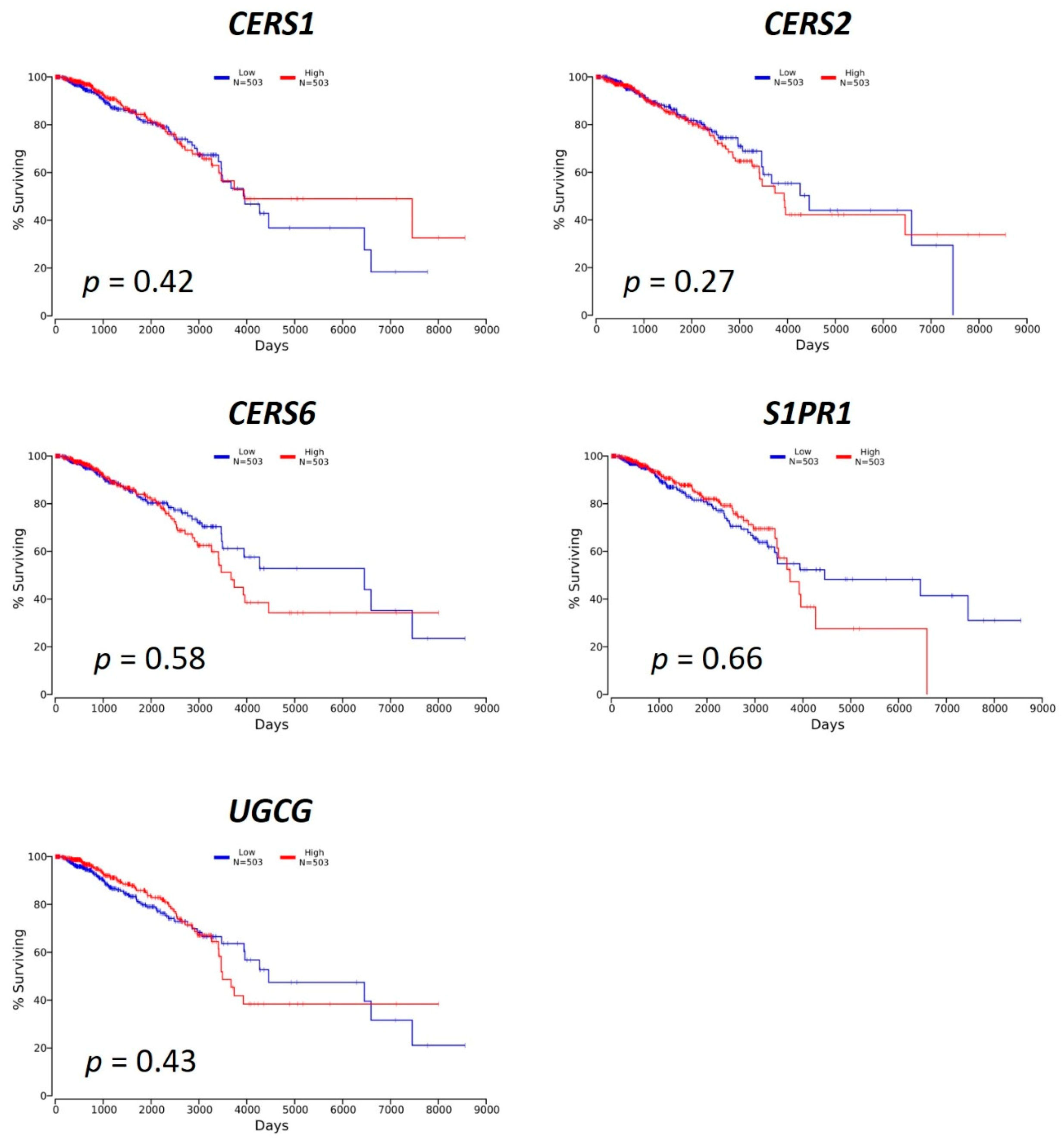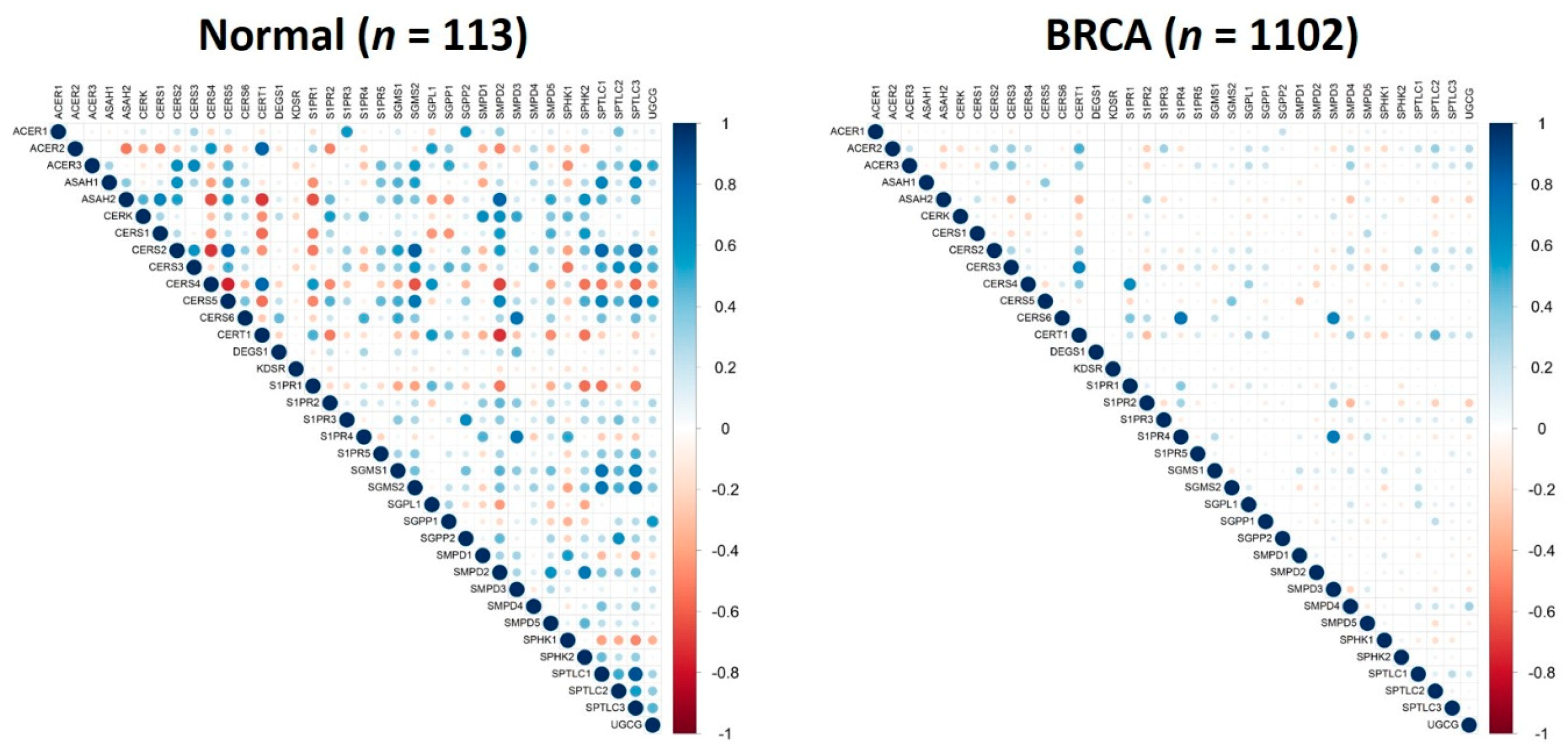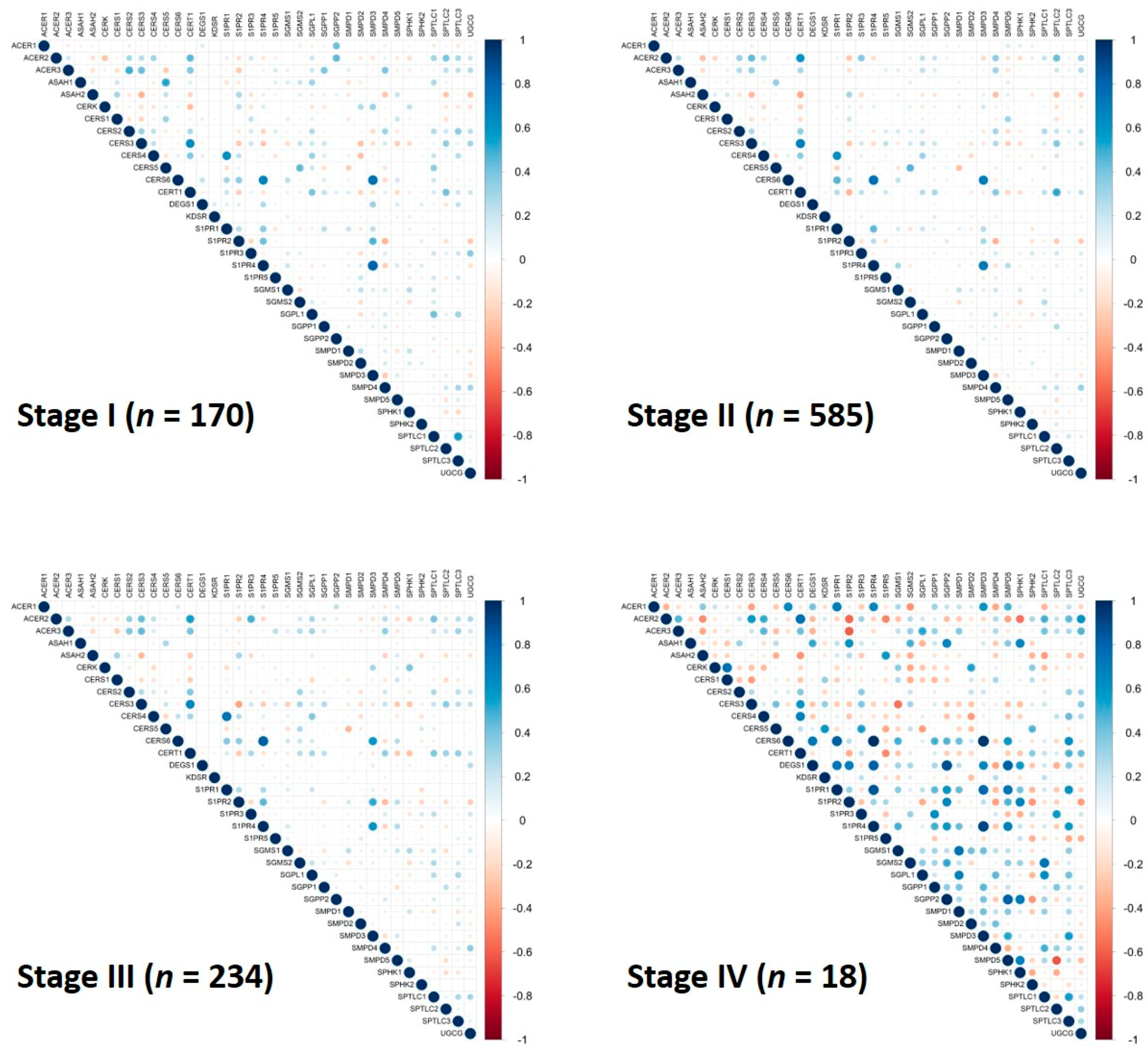Gene Pair Correlation Coefficients in Sphingolipid Metabolic Pathway as a Potential Prognostic Biomarker for Breast Cancer
Abstract
1. Introduction
2. Results and Discussion
3. Materials and Methods
3.1. Data Acquisition
3.2. Identification and Visualization of Differentially Expressed Genes
3.3. Computation of Correlation Matrix
4. Conclusions
Author Contributions
Funding
Conflicts of Interest
References
- Bray, F.; Ferlay, J.; Soerjomataram, I.; Siegel, R.L.; Torre, L.A.; Jemal, A. Global cancer statistics 2018: GLOBOCAN estimates of incidence and mortality worldwide for 36 cancers in 185 countries. CA Cancer J. Clin. 2018, 68, 394–424. [Google Scholar] [CrossRef] [PubMed]
- Canadian Cancer Statistics Advisory Committee. Canadian Cancer Statistics 2019; Canadian Cancer Society: Toronto, ON, Canada, 2019. [Google Scholar]
- Shields, M.; Wilkins, K. An update on mammography use in Canada. Health Rep. 2009, 20, 7–19. [Google Scholar]
- Holford, T.R.; Cronin, K.A.; Marriotto, A.B.; Feuer, E.J. Changing patterns in breast cancer incidence trends. J. Natl. Cancer Inst. Monogr. 2006, 36, 19–25. [Google Scholar] [CrossRef]
- Maceyka, M.; Spiegel, S. Sphingolipid metabolites in inflammatory disease. Nature 2014, 510, 58–67. [Google Scholar] [CrossRef] [PubMed]
- Huang, Y.; Mao, K.; Chen, X.; Sun, M.A.; Kawabe, T.; Li, W.; Usher, N.; Zhu, J.; Urban, J.F., Jr.; Paul, W.E.; et al. S1P-dependent interorgan trafficking of group 2 innate lymphoid cells supports host defense. Science 2018, 359, 114–119. [Google Scholar] [CrossRef] [PubMed]
- Goyal, G.; Zheng, J.; Adam, E.; Steffes, G.; Jain, M.; Klavins, K.; Hummel, T. Sphingolipid-dependent Dscam sorting regulates axon segregation. Nat. Commun. 2019, 10, e813. [Google Scholar] [CrossRef] [PubMed]
- Hammerschmidt, P.; Ostkotte, D.; Nolte, H.; Gerl, M.J.; Jais, A.; Brunner, H.L.; Sprenger, H.G.; Awazawa, M.; Nicholls, H.T.; Turpin-Nolan, S.M.; et al. CerS6-Derived Sphingolipids Interact with Mff and Promote Mitochondrial Fragmentation in Obesity. Cell 2019, 177, 1536–1552. [Google Scholar] [CrossRef] [PubMed]
- Dadsena, S.; Bockelmann, S.; Mina, J.G.M.; Hassan, D.G.; Korneev, S.; Razzera, G.; Jahn, H.; Niekamp, P.; Müller, D.; Schneider, M.; et al. Ceramides bind VDAC2 to trigger mitochondrial apoptosis. Nat. Commun. 2019, 10, e1832. [Google Scholar] [CrossRef] [PubMed]
- Pyne, N.J.; Pyne, S. Sphingosine 1-phosphate and cancer. Nat. Rev. Cancer 2010, 10, 489–503. [Google Scholar] [CrossRef] [PubMed]
- Saddoughi, S.A.; Garrett-Mayer, E.; Chaudhary, U.; O’Brien, P.E.; Afrin, L.B.; Day, T.A.; Gillespie, M.B.; Sharma, A.K.; Wilhoit, C.S.; Bostick, R.; et al. Results of a phase II trial of gemcitabine plus doxorubicin in patients with recurrent head and neck cancers: Serum C18-ceramide as a novel biomarker for monitoring response. Clin. Cancer Res. 2011, 17, 6097–6105. [Google Scholar] [CrossRef] [PubMed]
- Knapp, P.; Bodnar, L.; Błachnio-Zabielska, A.; Świderska, M.; Chabowski, A. Plasma and ovarian tissue sphingolipids profiling in patients with advanced ovarian cancer. Gynecol. Oncol. 2017, 147, 139–144. [Google Scholar] [CrossRef] [PubMed]
- Magen, A.; Das Sahu, A.; Lee, J.S.; Sharmin, M.; Lugo, A.; Gutkind, J.S.; Schäffer, A.A.; Ruppin, E.; Hannenhalli, S. Beyond Synthetic Lethality: Charting the Landscape of Pairwise Gene Expression States Associated with Survival in Cancer. Cell Rep. 2019, 28, 938–948. [Google Scholar] [CrossRef] [PubMed]
- Ling, B.; Chen, L.; Liu, Q.; Yang, J. Gene expression correlation for cancer diagnosis: A pilot study. Biomed. Res. Int. 2014, 2014, e253804. [Google Scholar] [CrossRef] [PubMed]
- Abuhussein, O.; Yang, J. Evaluating the antitumor activity of sphingosine-1-phosphate against human triple-negative breast cancer cells with basal-like morphology. Invest. New Drugs 2020. [Google Scholar] [CrossRef] [PubMed]
- Moro, K.; Kawaguchi, T.; Tsuchida, J.; Gabriel, E.; Qi, Q.; Yan, L.; Wakai, T.; Takabe, K.; Nagahashi, M. Ceramide species are elevated in human breast cancer and are associated with less aggressiveness. Oncotarget 2018, 9, 19874–19890. [Google Scholar] [CrossRef] [PubMed]
- Schiffmann, S.; Sandner, J.; Birod, K.; Wobst, I.; Angioni, C.; Ruckhäberle, E.; Kaufmann, M.; Ackermann, H.; Lötsch, J.; Schmidt, H.; et al. Ceramide synthases and ceramide levels are increased in breast cancer tissue. Carcinogenesis 2009, 30, 745–752. [Google Scholar] [CrossRef] [PubMed]
- Wegner, M.S.; Gruber, L.; Mattjus, P.; Geisslinger, G.; Grösch, S. The UDP-glucose ceramide glycosyltransferase (UGCG) and the link to multidrug resistance protein 1 (MDR1). BMC Cancer 2018, 18, 153. [Google Scholar] [CrossRef] [PubMed]
- OncoLnc. Available online: http://www.oncolnc.org (accessed on 5 June 2020).
- Naderi, A. SRARP and HSPB7 are epigenetically regulated gene pairs that function as tumor suppressors and predict clinical outcome in malignancies. Mol. Oncol. 2018, 12, 724–755. [Google Scholar] [CrossRef] [PubMed]
- Park, B.; Lee, W.; Park, I.; Han, K. Finding prognostic gene pairs for cancer from patient-specific gene networks. BMC Med. Genom. 2019, 12, e179. [Google Scholar] [CrossRef] [PubMed]
- TCGA-BRCA. Available online: https://portal.gdc.cancer.gov/projects/TCGA-BRCA (accessed on 15 May 2020).
- R. Available online: https://www.r-project.org (accessed on 15 May 2020).




| Gene Name | Log2FC | p Value | Gene Name | Log2FC | p Value |
|---|---|---|---|---|---|
| ACER1 | −0.05 | 0.75 | S1PR4 | 0.69 | <0.01 |
| ACER2 | −0.68 | <0.01 | S1PR5 | 0.51 | <0.01 |
| ACER3 | −0.27 | <0.01 | SGMS1 | −0.14 | 0.02 |
| ASAH1 | 0.13 | <0.01 | SGMS2 | −0.35 | <0.01 |
| ASAH2 | 0.25 | 0.69 | SGPL1 | 0.72 | <0.01 |
| CERK | −0.13 | <0.01 | SGPP1 | −0.31 | <0.01 |
| CERS1 | 1.16 | <0.01 | SGPP2 | 0.23 | 0.02 |
| CERS2 | 1.30 | <0.01 | SMPD1 | 0.14 | <0.01 |
| CERS3 | −0.04 | 0.83 | SMPD2 | 0.79 | <0.01 |
| CERS4 | 0.87 | <0.01 | SMPD3 | 0.90 | <0.01 |
| CERS5 | 0.23 | <0.01 | SMPD4 | 0.62 | <0.01 |
| CERS6 | 1.06 | <0.01 | SMPD5 | 1.66 | <0.01 |
| CERT1 | −0.85 | <0.01 | SPHK1 | 0.67 | <0.01 |
| DEGS1 | 0.45 | <0.01 | SPHK2 | 0.51 | <0.01 |
| KDSR | −0.44 | <0.01 | SPTLC1 | −0.03 | 0.44 |
| S1PR1 | −1.93 | <0.01 | SPTLC2 | 0.28 | <0.01 |
| S1PR2 | −0.32 | <0.01 | SPTLC3 | −0.28 | <0.01 |
| S1PR3 | 0.49 | <0.01 | UGCG | 1.22 | <0.01 |
© 2020 by the authors. Licensee MDPI, Basel, Switzerland. This article is an open access article distributed under the terms and conditions of the Creative Commons Attribution (CC BY) license (http://creativecommons.org/licenses/by/4.0/).
Share and Cite
Sakharkar, M.K.; Kaur Dhillon, S.; Chidambaram, S.B.; Essa, M.M.; Yang, J. Gene Pair Correlation Coefficients in Sphingolipid Metabolic Pathway as a Potential Prognostic Biomarker for Breast Cancer. Cancers 2020, 12, 1747. https://doi.org/10.3390/cancers12071747
Sakharkar MK, Kaur Dhillon S, Chidambaram SB, Essa MM, Yang J. Gene Pair Correlation Coefficients in Sphingolipid Metabolic Pathway as a Potential Prognostic Biomarker for Breast Cancer. Cancers. 2020; 12(7):1747. https://doi.org/10.3390/cancers12071747
Chicago/Turabian StyleSakharkar, Meena Kishore, Sarinder Kaur Dhillon, Saravana Babu Chidambaram, Musthafa Mohamed Essa, and Jian Yang. 2020. "Gene Pair Correlation Coefficients in Sphingolipid Metabolic Pathway as a Potential Prognostic Biomarker for Breast Cancer" Cancers 12, no. 7: 1747. https://doi.org/10.3390/cancers12071747
APA StyleSakharkar, M. K., Kaur Dhillon, S., Chidambaram, S. B., Essa, M. M., & Yang, J. (2020). Gene Pair Correlation Coefficients in Sphingolipid Metabolic Pathway as a Potential Prognostic Biomarker for Breast Cancer. Cancers, 12(7), 1747. https://doi.org/10.3390/cancers12071747





